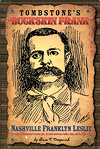Tombstone’s ‘Buckskin Frank’: Nashville Franklyn Leslie, by Ben T. Traywick, Red
Marie’s, Tombstone, Ariz., 2013, $12.50
The subhead of this new and greatly expanded version of a 1985 book by Ben Traywick, former town historian of Tombstone, Arizona, sounds fantastical: The Story of Tombstone’s Fastest Gun, its Most Notorious Ladies’ Man and its Biggest Liar. This character surely must be fictional—a mythical blend of the fighting Earp brothers, Doc Holliday, John Behan, John Ringo and a few  other Cowboys all rolled into one. Not so. Nashville Franklyn Leslie is hardly unknown (though “Franklin” is the way his first name usually appears) to Old West aficionados, and several of his killings are well documented—the June 1880 shooting, with the help of friend George Perrine, of Mike Killeen (followed by Leslie’s marriage to the late Killeen’s widow, May, a week later); the November 1882 shootout in which he got the best of Billy Claibourne, a dropout from the Gunfight at the O.K. Corral; and the July 1889 shooting death of Bird Cage entertainer Mollie Williams after a drunken quarrel (Leslie also shot witness Jim Neal who, unfortunately for Buckskin Frank, survived). Traywick, author of some 35 books, says this 189-page work required 28 years of research by himself and his able assistants (Michael Hiebert, Cathie Grant, David and Dayna Goron, and Mary Dolores, the latter of whom Traywick married in 2002). Traywick’s 1985 book was only 39 pages. In 1999 Don Chaput came out with a 144-page book Buckskin Frank Leslie: Scout, Gunman, Rancher, Lady Killer.
other Cowboys all rolled into one. Not so. Nashville Franklyn Leslie is hardly unknown (though “Franklin” is the way his first name usually appears) to Old West aficionados, and several of his killings are well documented—the June 1880 shooting, with the help of friend George Perrine, of Mike Killeen (followed by Leslie’s marriage to the late Killeen’s widow, May, a week later); the November 1882 shootout in which he got the best of Billy Claibourne, a dropout from the Gunfight at the O.K. Corral; and the July 1889 shooting death of Bird Cage entertainer Mollie Williams after a drunken quarrel (Leslie also shot witness Jim Neal who, unfortunately for Buckskin Frank, survived). Traywick, author of some 35 books, says this 189-page work required 28 years of research by himself and his able assistants (Michael Hiebert, Cathie Grant, David and Dayna Goron, and Mary Dolores, the latter of whom Traywick married in 2002). Traywick’s 1985 book was only 39 pages. In 1999 Don Chaput came out with a 144-page book Buckskin Frank Leslie: Scout, Gunman, Rancher, Lady Killer.
Trying to track down the truth about Leslie, even for someone with Traywick’s credentials as a popular historian, is like trying to find a firing pin in a haystack. “He led an unbelievable life filled with many contradictions and told monstrous lies about it at every turn,” Traywick says in his introduction. “His adventurous life is almost impossible to comprehend. It is entirely possible that he broke every law ever written. Still, men liked him and women could not resist him.” One woman, Mollie Williams, did not live long enough to regret it. “Leslie,” says Traywick,” was the only man in the entire American West who killed a woman and didn’t get the hang rope, or someone didn’t shoot him before that.” This lady killer got a life sentence but served less than seven years—another amazing fact about Leslie. Still, many details of his life (including exactly where and when he died) will forever remain a mystery. Traywick and team do provide the reader with everything they discovered (mainly through newspaper accounts; there is no index, and all documentation comes within the text itself) about a man who might not actually have been the fastest gun, most notorious ladies’ man and biggest liar in Tombstone but was close enough in each category to rate as arguably one of the most interesting men in Arizona Territory. Traywick manages to slip in a dig at John Ringo (“If his name had been Ralph Baumgarner, we would never have heard of him!”). This leads us to wonder about Nashville Franklyn Leslie. What if his name had been “Buckskin Ralph” Baumgarner? Fortunately, it was not.
Editor




